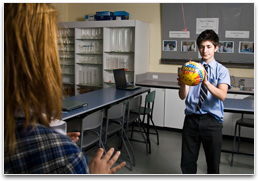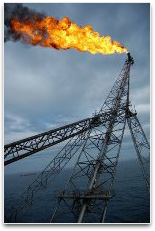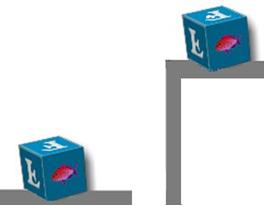This focus idea is explored through:
Contrasting student and scientific views
Student everyday experiences
 Energy is a word students frequently encounter and use every day. Many of the experiences they have and the ideas they construct from these experiences lead students to the view that energy is not conserved.
Energy is a word students frequently encounter and use every day. Many of the experiences they have and the ideas they construct from these experiences lead students to the view that energy is not conserved.
While students commonly accept that it takes energy to make changes they see happening in their world, they often do not believe that (new forms of) energy are still present after the change. For example, most students will agree that energy is needed to heat up a cup of cold water, to get a stationary ball rolling or to lift a box up onto a shelf. Many will, however, hold the view that the cup of hot water, the rolling ball and the high box do not have more energy after the change process has ended.
The common meaning of the word ‘potential’ refers to something that you do not have now but may have in the future. This creates difficulties for students with the scientific phrase ‘potential energy’. Students see the various forms of potential energy as not being energy but rather as the potential to gain energy. Once again students do not see energy as being conserved. For example they see a box on a high shelf as not having more energy (i.e. gravitational potential energy) than an identical box on a lower shelf. Rather they see it could gain kinetic energy if pushed off the shelf (has the ‘potential’ to gain energy).
Most students have a considerably more restricted view of what phenomena are forms of energy than do scientists. Many students do not see that diverse changes such as raising things, stretching things, speeding things up, burning fuels and producing light or sound involve the common attribute of energy.
This issue of what counts as energy is compounded by the very abstract notions of chemical and nuclear energy – it is easy to conceive of the effects when these forms of energy are transformed into others, but very much more difficult to build a mental picture of how these could be thought of as forms of energy before such transformations occur.
 These student ideas cause problems of learning that are further explored in the focus idea
Energy producing and consuming reactions.
These student ideas cause problems of learning that are further explored in the focus idea
Energy producing and consuming reactions.
A different aspect of students’ experiences with conservation of energy is the conundrum presented in the title: ‘Is energy conserved or running out?’ Students’ experiences of the media suggest that human society is facing an increasingly dire shortage of energy and that we are wasting/losing energy at unsustainable rates. Phrases such as ‘We need to conserve energy’ use the word conserve in a very different way from its meaning in the phrase ‘Energy is always conserved’.
Research: Brook, Briggs, Bell, & Driver (1984),
Carr, Kirkwood, Newman & Birdwhistel (1987),
Driver & Millar (1986),
Duit & Haeussler (1994),
Watts (1983)
Scientific view
The concept of energy and our understanding that it is conserved have taken a long time to develop and are invented ideas created to better understand changes that occur in our world. Scientists do not know what energy is.
A cup that has been heated, a ball that has accelerated and a box that has been lifted higher all have more energy than they had - heat, kinetic and gravitational
potential energy respectively. Each could transfer this energy to another system (e.g. the hot water will heat up a teaspoon placed in it, the moving ball could speed up another ball). These statements about what sorts of energy are present in a system only have meaning when we include what might happen next. For example, a rolling wooden ball can be regarded as a store of
kinetic energy in the context of collisions with other balls, or as a store of chemical energy if it is about to be burnt.
The various forms of energy labelled ‘potential energy’ are forms of energy that systems currently have, not that they will gain in the future. A stretched spring has more energy than it did before it was stretched; energy in this form is called elastic potential energy. Similarly a girl who has climbed a ladder has more (gravitational potential) energy than she had at the base of the ladder. Changes in chemical energy arise from changes in both the kinetic and
electrostatic potential energy of electrons in
atoms and
molecules;
nuclear energy arises from the (different) forces that hold protons and neutrons together in nuclei.
The total amount of energy in the universe never changes in any energy transformation. In appliances, machines, and the human body, some of the energy is transformed into sound and low grade heat energy (e.g. the moving parts get warmer). Almost no low grade heat energy can be turned into useful work. We cannot use energy in these low grade forms to run another appliance so we commonly say that energy is ‘used up’. However, it is really that useful energy that is being transformed to non-useful energy.
The fact that we cannot turn low grade heat energy into useful work means that the commonly quoted definition of energy as ‘the capacity to do work’ is unsatisfactory – it is only applicable to mechanical energy.
Critical teaching ideas
- The concept of energy was invented over a long period of time as a concept to explain a wide range of changes. Energy has many forms. It can be measured and the units - Joules and calories - apply to all forms.
- In most changes that we observe energy is changing form. Energy transforming devices are central to our society. It helpful to describe the energy they require as ‘usable’ energy.
- The concept of energy can be used to describe changes and the ability to make changes.
- The phrase ‘we need to conserve energy’ uses the word ‘conserve’ differently from its use in the phrase ‘the conservation of energy’. When conserving energy we are concerned with limiting the use of ‘usable’ forms of energy.
- The principle of the conservation of energy refers to the idea that energy is not created or lost – it is only transformed from one form to another. In all changes some energy is always converted into forms (mainly low grade heat) that cannot be used to make further changes.
 Explore the relationships between ideas about observation and fieldwork in the
Concept Development Maps – Energy Transformations and Energy Resources.
Explore the relationships between ideas about observation and fieldwork in the
Concept Development Maps – Energy Transformations and Energy Resources.
 The views that students have about energy and energy conservation make teaching the principle of conservation of energy a lot trickier than is often appreciated. Attempts to teach energy by starting from a textbook definition are not helpful because they do not apply to all situations involving energy. The common definition of energy as the ‘capacity to do work’, for example, ignores the huge issue that low grade heat cannot be used to do work. Hence it is better to try and describe energy rather than search for a single definition. Energy changes can be measured and energy can be thought of as an accounting system that allows us to compare, for example, the amounts of energy required to produce different materials such as paper, plastic and glass cups, or the efficiencies of various energy transforming devices such as different types of engines.
The views that students have about energy and energy conservation make teaching the principle of conservation of energy a lot trickier than is often appreciated. Attempts to teach energy by starting from a textbook definition are not helpful because they do not apply to all situations involving energy. The common definition of energy as the ‘capacity to do work’, for example, ignores the huge issue that low grade heat cannot be used to do work. Hence it is better to try and describe energy rather than search for a single definition. Energy changes can be measured and energy can be thought of as an accounting system that allows us to compare, for example, the amounts of energy required to produce different materials such as paper, plastic and glass cups, or the efficiencies of various energy transforming devices such as different types of engines.
Teaching activities
As noted in focus idea,
Using energy, this is an area where students’ existing conceptions need reshaping, but are not strongly held. It is important to emphasise that while there is good evidence that suggests that energy is always conserved, in at least the great majority of situations, this cannot be verified with experiments. This is because some energy is always transformed into low grade forms that cannot be measured. Teaching will involve some presentation (rather then discovery or proving from experiment) of current science, however reasons why scientists find it useful to use the notion of energy in the way they do will need to be regularly discussed.
Promote reflection on and clarification of existing ideas
This activity is designed to bring out students’ views on whether the energy needed to make a change remains in the system. Stress that this is not a test, but a starting point for discussion and ask students to select one of the three opinions for each situation. The activity should also encourage students to rethink their ideas where necessary.
Below are three pairs of objects. One object of each pair has had a change made to them. Students should select the statement that best describes their opinion about the changes that have occurred:
1) A cup of cold water; the same cup but now with hot water In my opinion:
a) energy was not involved in any way
b) the hot water has more energy than the cold water
c) it did take energy to heat the cold water, but the hot water does not have more energy now. |

|
2) A stationary ball; the same ball but rolling In my opinion:
a) energy was not involved in any way
b) the moving ball has more energy than the still ball
c) it did take energy to get the ball moving, but the moving ball does not have more energy now. |

|
3) A box on the ground; the same box on a high shelf In my opinion:
a) energy is not involved in any way
b) the high box has more energy than the low box
c) it did take energy to lift the box, but the high box does not have more energy than the low box. |

|
Many students will select opinion B (the scientifically acceptable one) for each situation. After collecting votes, call for discussion about the first situation (the glass of water). This and the ball situation are ones where students who hold opinion B are usually able to convince their colleagues: they can cite experience that you need energy-using appliances to heat water and (separately) that the hot water could heat up something else; equivalent arguments apply to the rolling ball. The third situation (the box) is more difficult as it involves a less obvious form of energy, however prior agreement on opinion B for the first two situations is useful in exploring the third situation.
Bring out students' existing ideas
The following activity is a useful probe of students’ ideas about what are forms of energy. As can be seen from the responses from a year 9 class, the students’ ideas vary and are often unclear rather than being in strong conflict with accepted science.
In the table below are some situations where a change is actually occurring. Present these to the students and ask, ‘Would you use the word energy in thinking about these situations? If yes, explain how.’ Students should also be encouraged to consider if more than one type of energy is involved, and to list them all
Summaries of some Year 9 students’ ideas are also provided, as a guide to possible student responses.
| Situation | Year 9 Student Responses |
|---|
| An electrical radiator glows red hot | -
Many students wrote that electrical energy went in.
-
Some wrote heat energy came out.
|
| An electric blender is whirring quickly and loudly | -
Many wrote that electrical energy went in.
-
Some students then had many types of energy coming out.
|
| A nuclear bomb explodes | -
Nuclear energy in and out.
-
Nuclear in but don’t know what comes out.
-
Nuclear in, radioactive out.
|
| A boy eats a Mars bar | -
Chocolate gives energy.
-
The body uses energy to chew.
-
Movement is energy.
-
Food is energy.
-
There is energy in the Mars bar.
|
| An apple tree grows apples | -
The sun’s rays put energy in.
-
Tree needs energy to grow.
-
Light and heat energy go in.
|
| The apple tree is burning in a big fire | -
The fire uses energy but don’t know what it is called.
-
Heat energy is given out.
-
Light energy is given out.
|
| A man has stacked many boxes on a high shelf | -
Almost all the students wrote that energy had been used.
-
Very few students identified a specific form of energy.
|
| A skier races down a slope | -
The students knew that the skier had used energy but they couldn’t give it a name.
|
| A lump of plasticine is thrown onto a large gong | -
The thrower uses energy and a sound is made which is energy.
|
| A slingshot is stretched | -
Energy was used to stretch the elastic.
-
There was energy used to move the arm that did the stretching.
-
We are making a force by stretching it.
|
| The slingshot snaps forward firing the stone | -
The students wrote that energy was used but that they didn’t know what to call it.
|
Focus students' attention on overlooked detail
Without introducing the notion of conservation of energy, ask students to refer back to their responses to the probe above. The overall goal is to try to construct a class list of forms of energy that all students agree on. The group activity means that, as some students suggest a form of energy in each picture that others may overlook, the class is likely to expand the list of forms of energy they recognise.
Divide the class into small groups to complete the table below. The table looks at the forms of energy going in and coming out in several (or all) of the situations in the probe detailed above. Within their groups, the students must decide whether they agree or disagree on the forms of energy going in and out. The groups may decide that no energy is going in or out and this is acceptable. The idea behind completing this activity is to make a more comprehensive list of ideas about forms of energy. Each of the groups should report back to the rest of the class and the list should be added to as different forms are suggested and agreed upon.
SITUATION |
ENERGY IN |
ENERGY OUT |
agree |
disagree |
agree |
disagree |
Electric mixer
(practice) | | | | |
Slingshot
stretched | | | | |
Slingshot
fires | | | | |
Boxes | | | | |
Skier | | | | |
Digesting a
Mars bar | | | | |
Apple tree
growing | | | | |
Tree burning | | | | |
Helping students work out some of the ‘scientific’ explanation for themselves
After some discussion of group opinions about forms of energy, introduce the story of 19th Century scientists gradually inventing the idea that energy must always be conserved and extending their range of forms of energy. The class can then look at what they have come up with and identify where there must forms of energy that they had not included in either column.
Open discussion via a shared experience
The following POEs (Predict-Observe-Explain) involve energy transformation in moving balls. A moving ball is said to have more energy than an identical still ball. This type of energy - the energy of movement - is called
kinetic energy.
Set up the following situations for students to consider:
The students should be asked to decide if the ball will roll up the opposite slope to the same height as it started from (near to position D), or roll the same distance along the track (near position E). Discussion of these predictions and the observed result should focus on the original gravitational potential energy being transformed to kinetic energy as the ball speeds up and then back into gravitational potential energy as the ball rolls up the opposite slope.